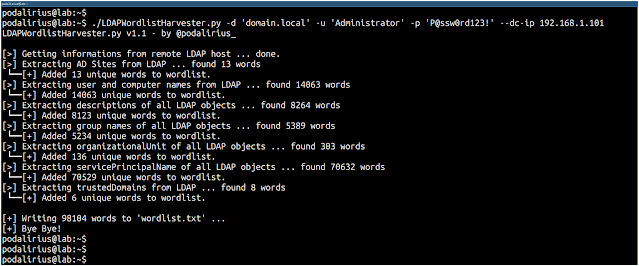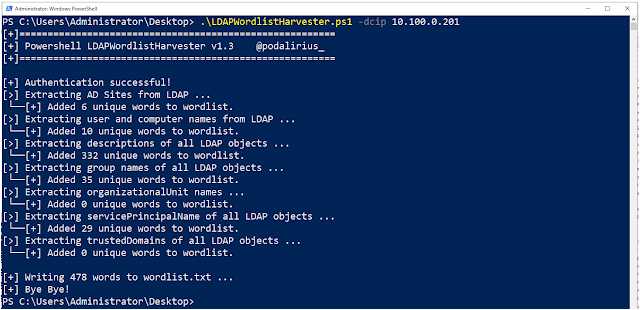LDAPWordlistHarvester – A Tool To Generate A Wordlist From The Information Present In LDAP, In Order To Crack Passwords Of Domain Accounts
A tool to generate a wordlist from the information present in LDAP, in order to crack non-random passwords of domain accounts.

Features
The bigger the domain is, the better the wordlist will be.
- [x] Creates a wordlist based on the following information found in the LDAP:
- [x] User:
nameandsAMAccountName - [x] Computer:
nameandsAMAccountName - [x] Groups:
name - [x] Organizational Units:
name - [x] Active Directory Sites:
nameanddescriptions - [x] All LDAP objects:
descriptions - [x] Choose wordlist output file name with option
--outputfile
Demonstration
To generate a wordlist from the LDAP of the domain domain.local you can use this command:
./LDAPWordlistHarvester.py -d 'domain.local' -u 'Administrator' -p 'P@ssw0rd123!' --dc-ip 192.168.1.101
You will get the following output if using the Python version:
You will get the following output if using the Powershell version:
Cracking passwords
Once you have this wordlist, you should crack your NTDS using hashcat, --loopback and the rule clem9669_large.rule.
./hashcat --hash-type 1000 --potfile-path ./client.potfile ./client.ntds ./wordlist.txt --rules ./clem9669_large.rule --loopback
Usage
$ ./LDAPWordlistHarvester.py -h
LDAPWordlistHarvester.py v1.1 - by @podalirius_
usage: LDAPWordlistHarvester.py [-h] [-v] [-o OUTPUTFILE] --dc-ip ip address [-d DOMAIN] [-u USER] [--ldaps] [--no-pass | -p PASSWORD | -H [LMHASH:]NTHASH | --aes-key hex key] [-k]
options:
-h, --help show this help message and exit
-v, --verbose Verbose mode. (default: False)
-o OUTPUTFILE, --outputfile OUTPUTFILE
Path to output file of wordlist.
Authentication & connection:
--dc-ip ip address IP Address of the domain controller or KDC (Key Distribution Center) for Kerberos. If omitted it will use the domain part (FQDN) specified in the identity parameter
-d DOMAIN, --domain DOMAIN
(FQDN) domain to authenticate to
-u USER, --user USER user to authenticate with
--ldaps Use LDAPS instead of LDAP
Credentials:
--no- pass Don't ask for password (useful for -k)
-p PASSWORD, --password PASSWORD
Password to authenticate with
-H [LMHASH:]NTHASH, --hashes [LMHASH:]NTHASH
NT/LM hashes, format is LMhash:NThash
--aes-key hex key AES key to use for Kerberos Authentication (128 or 256 bits)
-k, --kerberos Use Kerberos authentication. Grabs credentials from .ccache file (KRB5CCNAME) based on target parameters. If valid credentials cannot be found, it will use the ones specified in the command line
A considerable amount of time and effort goes into maintaining this website, creating backend automation and creating new features and content for you to make actionable intelligence decisions. Everyone that supports the site helps enable new functionality.
If you like the site, please support us on “Patreon” or “Buy Me A Coffee” using the buttons below
To keep up to date follow us on the below channels.




![Cobalt Strike Beacon Detected - 20[.]74[.]209[.]192:8081 5 Cobalt-Strike](https://www.redpacketsecurity.com/wp-content/uploads/2021/11/Cobalt-Strike-300x201.jpg)
